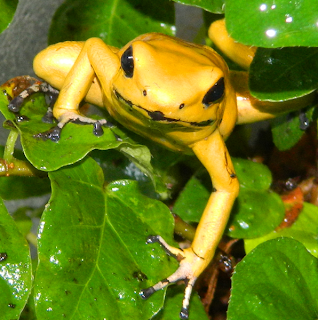Monday, July 29, 2013
Friday, July 19, 2013
Monday, March 04, 2013
Tuesday, December 18, 2012
10 Most Poisonous Frogs on Earth
1) Dendrobates azureus:
As children, many of us kept frogs we had found in jars and vivariums, or just took them home to show to our friends. The frogs on this list are a different ball of wax, not creatures anyone in their right mind would want to play with or even touch - in many cases, in fact, they are deadly poisonous.
2) Golden poison dart frog
These frogs use their poison solely for self-defense, not to kill prey, and what a good defense against predators it is. Many of them are poison dart frogs known for their use in making arrow poisons. Beautiful but deadly – it's definitely a case of look but don't touch with these suckers!
These frogs use their poison solely for self-defense, not to kill prey, and what a good defense against predators it is. Many of them are poison dart frogs known for their use in making arrow poisons. Beautiful but deadly – it's definitely a case of look but don't touch with these suckers!
3. Giant Leaf Frog (Phyllomedusa bicolor)
4. Dyeing Dart Frog (Dendrobates tinctorius)
5. Red-backed Poison Frog (Ranitomeya reticulatus)
6. Strawberry Poison Dart Frog (Oophaga pumilio)
With its bright red skin, the tiny strawberry poison dart frog, native to Central America, is one of the most beautiful of the species listed here. Its poison is pretty toxic stuff, causing swelling and a burning sensation, but is still far weaker than that of the Phyllobates genus of poison dart frogs, for example. 7. Lovely Poison Frog (Phyllobates lugubris)
Also known as the striped poison dart frog, Central America's lovely poison frog is the least toxic in thePhyllobates genus, and yet it still produces dangerous toxins. The amount of toxin is thought to be comparatively low, ranging from nothing to 0.8 micrograms, but this frog is still far from harmless and can cause heart failure in predators that risk eating it. Don't be fooled by its name! (Well, it does look quite lovely.)
8. Golfodulcean Poison Frog (Phyllobates vittatus)
9. Splash-backed Poison FrogRanitomeya variabilis
10. Phantasmal Poison Frog (Epipedobates tricolor)
Monday, December 10, 2012
The Most Dangerous Creatures of the Sea
Lionfish
Members of the Scorpaenidae fish family, the Lionfish are native to the Indian and Pacific oceans but various species can be found all over the world. Also known as the Turkey Fish or Dragon Fish, it has long poisonous spines that are deadly to many marine creatures. The Lionfish sting is not usually deadly to humans but it will cause severe pain, headaches and vomiting. Lionfish attack people unless provoked, but in case you get stung you should immediately soak the area in hot water and seek medical help.
StonefishMembers of the Scorpaenidae fish family, the Lionfish are native to the Indian and Pacific oceans but various species can be found all over the world. Also known as the Turkey Fish or Dragon Fish, it has long poisonous spines that are deadly to many marine creatures. The Lionfish sting is not usually deadly to humans but it will cause severe pain, headaches and vomiting. Lionfish attack people unless provoked, but in case you get stung you should immediately soak the area in hot water and seek medical help.
Wednesday, September 12, 2012
THE WORLD'S TALLEST DONKEY

A mule named 'Oklahoma Sam' is today celebrating being crowned the 'Tallest Living Donkey' on the planet.
Measuring 15.3 hands (155.45 cm; 5ft 1in) tall, she dwarfs the common donkey (8 hands high) and her own larger 'Mammoth Jackstock' breed (12 hands high).
The four-year-old record-breaker lives in Watsonville, California, USA, where she shares her one acre of land with a Macaw, duck, goose and four cats.
The other animals, unfazed by Sam's size, enjoy playing with the giant donkey, and when Sam isn't chasing them around the farmland she can usually be found sleeping in an area of shade or nibbling on her bale.
Sam's overall care is handled by 54-year-old Linda Davis, a keen gardener and animal lover.
Linda, who calls Sam her "soul mate", says: "It actually doesn't cost anymore to have a donkey of this size.
"He doesn't eat more. In fact, if I give him more bale he'll just use it to make his bedding more comfortable. He loves his sleep"
Monday, September 03, 2012
Psittacula Bird Species

These brightly-colored Asian and African parakeets are often kept as aviary birds, but they’re making their way into homes as pets with their grace and social nature. Psittacula parakeets earned a reputation as nippy, noisy birds, but their pet bird owners are fiercely loyal to them, pointing out their good qualities, such as their easy-going and independent nature. Fourteen species make up the Psittacula genus, but the plum-headed, ring-necked, Alexandrine and moustached parakeets are the most common species kept as pets in the United States.
Subscribe to:
Comments (Atom)


























